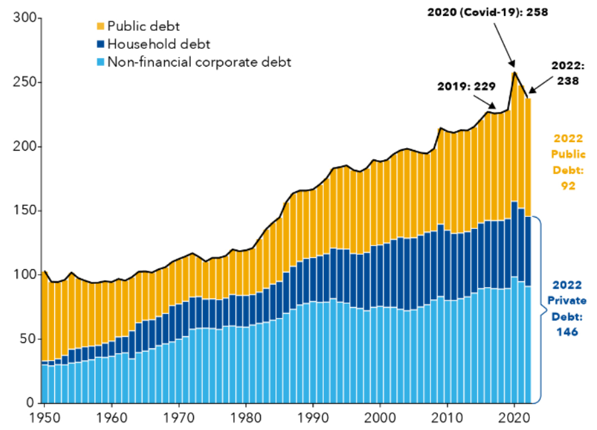Context:
According to the Institute of International Finance, the combined global debt of households, businesses, and governments has surged to $315 trillion in 2024.
What is global debt?
• Global debt refers to the loans taken by governments, private businesses, and individuals.
- Governments borrow to cover expenses exceeding their tax income, and sometimes to pay interest on previously taken loans.
- The private sector mainly borrows for investment purposes.
Present status of worldwide growing debt:
- This total global debt is three times the global gross domestic product (GDP).
- Global public debt (both domestic and external borrowing by governments) reported a steep hike, reaching US$97 trillion in 2023, an increase of US$5.6 trillion over 2022.
- Developing countries share 30 percent of the total global debt. However, the debt growth rate of developing countries is twice that of developed countries.
- Household debt stands at $59.1 trillion, business debt at $164.5 trillion, and public debt at $91.4 trillion.
- In Africa the per capita spending on interest is US$70, which is higher than US$60 per capita for education and US$39 for health.

- In 2023, developing nations spent $847 billion on interest payments, a 21% increase from 2021, with interest rates up to four times higher than those in the US.
Major reasons for growing debt among developing nations:
- There’s been a decline in overall aid over the past two years.
- The increasing public debt in developing countries may be caused by shifts in the profile of development aid.
• Concessional loans are substituting aid, thereby increasing debt burdens.

- For instance, loans accounted for 28% of aid in 2012, rising to 34% by 2022.
- The assistance aimed at reducing debt among developing countries, including relief measures, has decreased significantly, dropping from $4.1 billion in 2012 to $300 million in 2022.
Impact of large debt on developing countries:
- Public debt restricts development spending, particularly affecting developing countries where a significant amount of share of funds are spent on infrastructure projects.
- If countries default on their debts, it can trigger panic in financial markets and lead to economic slowdowns.
- For businesses, the burden of repaying high levels of debt reduces funds available for job creation and expansion and increases the risk of insolvency.
- Households facing high debt levels may be forced to cut spending on essentials like food and fuel, with low-income households being the most vulnerable.
- High debt emerges as a key obstacle to achieving Sustainable Development Goals (SDGs) by 2030.
Addressing this issue requires a strategic approach, including increased aid, concessional loans and Negotiating a debt waiver deal to support sustainable development and financial stability in vulnerable economies.

